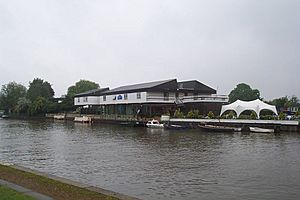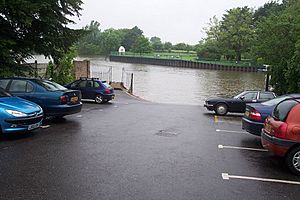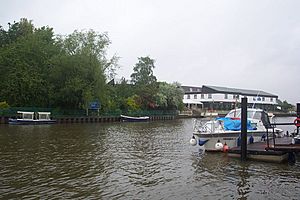Raven's Ait facts for kids
Raven's Ait is a small island, called an ait, located in the River Thames in London, England. It sits between the towns of Surbiton and Kingston upon Thames. For many years, Raven's Ait was a popular place for boating and water sports training. Today, it is a private venue used for special events like parties, conferences, and weddings.
Contents
Exploring Raven's Ait: Location and Access
Raven's Ait is an island in the River Thames. It is found between Surbiton, Kingston, and Hampton Court Park. The island is in the middle of the river's non-tidal part, which means the water level doesn't change with the ocean tides.
You can get to the island by taking a small ferry. The ferry leaves from Queen's Promenade, which is on the south side of the Thames. This area is near the Thames Sailing Club.
A Look Back: The History of Raven's Ait
Raven's Ait has a long and interesting history. Some people believe important documents linked to the 1215 Magna Carta might have been signed here. The Magna Carta was a famous agreement that limited the power of the king.
Boating and Training on the Island
In more recent times, Raven's Ait became well-known as a boating center. The Kingston Rowing Club, which started in 1858, used to be based here. They now have a clubhouse in Kingston.
For many years, the island was home to a group called The Navy League. This charity ran a training center called TS Neptune. Here, young people learned how to sail, canoe, and boat with naval discipline. Even the Duke of Edinburgh visited the center in 1958. The Navy League stopped using the island in 1971.
Changes to the Island's Buildings
The original buildings on the island were made of wood and painted "Sea Cadet Blue." They had old-style dormitories where the cadets slept. In 1971, almost all the buildings were rebuilt. New structures replaced the old wooden ones, creating the island buildings you see today.
New Uses and Challenges
During the 1980s, the Inner London Education Authority used Raven's Ait. They ran it as a training center for youth workers and a place for water sports. In 1989, the island was sold to Kingston Borough Council.
The council then rented the island to a company called Ravens Ait Hall Management Company Ltd. This company used the island as a place for conferences and weddings. However, the company faced financial problems and closed in December 2008.
In early 2009, some people moved onto the island without permission. They wanted to turn it into an eco-friendly conference center. Kingston Council, who owned the island, took legal action. The people were asked to leave on May 1, 2009.
Since 2009, Raven's Ait has continued to be a popular place for weddings and company events.
Water Sports at Raven's Ait: A Closer Look
When Raven's Ait was a water sports center, it was approved by important groups like the Royal Yachting Association. This meant they could teach sailing and canoeing. The island also had a special boat called Sparkle. This catamaran was designed so people with physical disabilities could sail it.
Learning Motor Boating Skills
The center used various boats for teaching motor boating. Most of these boats were powered by diesel engines. They included naval cutters, open tenders called "Vikings," and a workboat. There was also a small, sturdy open boat known as "Number 8."
Rowing Training
Basic rowing skills were taught at Raven's Ait. Students, often Sea Cadets, learned to row in special boats. These included the ASC (Admiralty Sailing Craft) or larger boats called admiralty whalers. These whalers were designed for naval rowing races.
Sailing Adventures
The sailing boats at Raven's Ait were a mix of naval boats and stronger versions of regular dinghies.
Here are some of the types of sailing boats used:
- ASCs: These were 16-foot gaff-rigged dinghies, often moored right next to the island.
- Bosuns: These dinghies were said to be strong enough to be lifted from large ships in the middle of the ocean.
- Cadets: This type of dinghy was designed for two children up to 17 years old to sail.
- Coypus: These were short, wide, and slow gaff-rigged dinghies.
- Fireballs: These faster boats were kept at Island Barn Reservoir for special training that involved using a trapeze.
- GP14s: These were heavily strengthened versions of a popular dinghy.
- Puffin Pacers: These light dinghies had a tendency to scoop up water when turning sharply.
Schools Using Raven's Ait
Many schools used Raven's Ait for water sports training when it was run by the Navy League. Some of these schools included:
- Epsom College
- Stockwell Manor
- Forest Hill School
- Glyn County Grammar School
- Sutton County Grammar School






